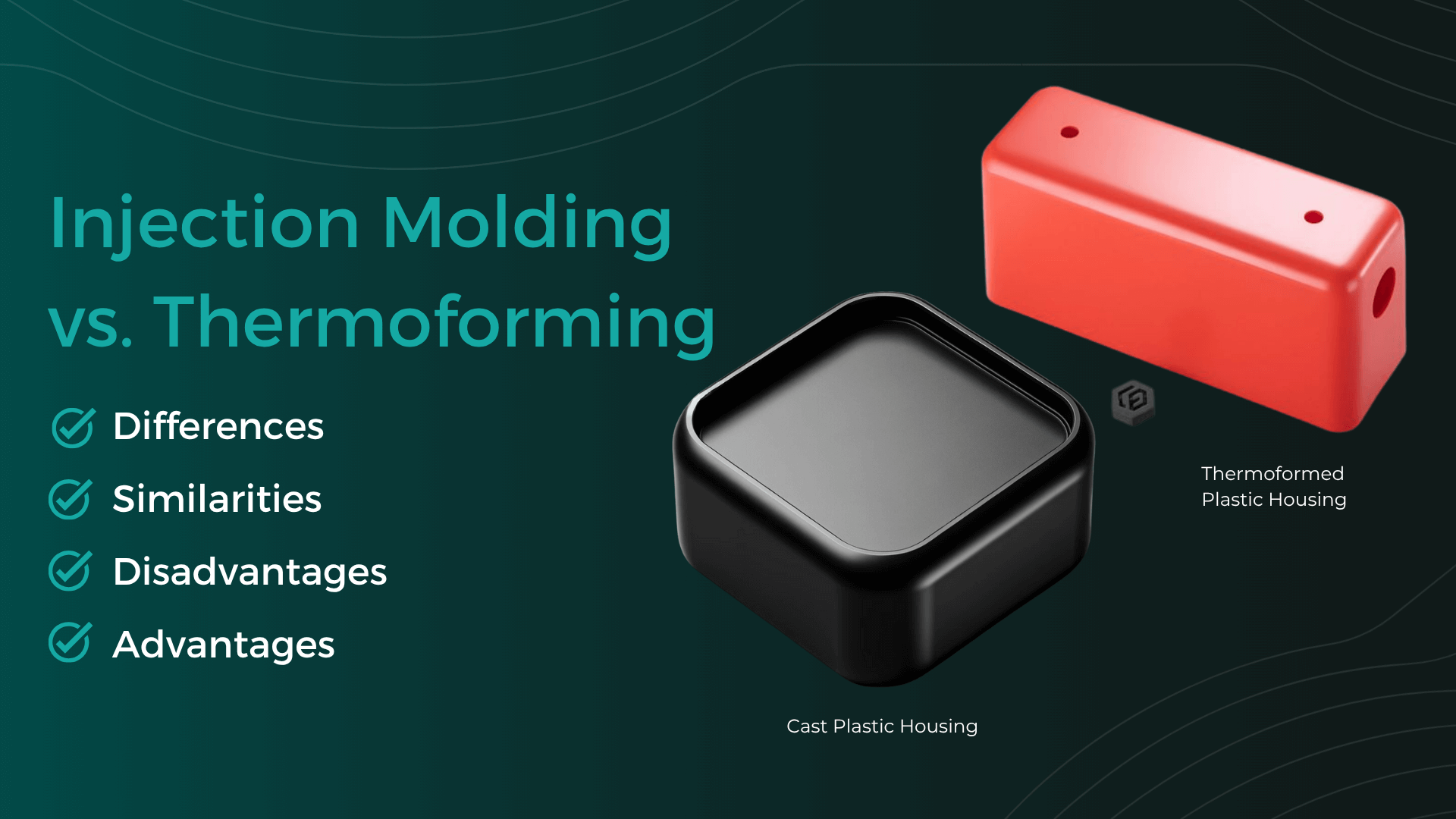Injection Molding vs. Plastic Thermoforming – Advantages, Disadvantages, Differences, and Similarities
In the world of plastic processing, there are various common manufacturing methods used to produce precise plastic components for industrial applications. We compare two of them: Injection Molding and Plastic Thermoforming.

Sarah Guaglianone
2. Juni 2025

Contents
Both processes are suitable for various industries and applications, making it essential to understand their similarities, differences, advantages, disadvantages, and use cases. In this article, we compare injection molding and thermoforming to help you make the best decision for your specific application.
What Is Injection Molding?
Injection molding is a widely used manufacturing process for producing plastic parts. It involves injecting molten plastic into a mold—hence the name. The plastic solidifies through hydraulic cooling, and once the mold opens, the finished part is ejected. But how exactly does the injection molding process work? Let's break it down.
How Does the Injection Molding Process Work?
- Melting the Plastic: Plastic granules are heated until they become liquid. The mold, also known as the injection mold tool, is closed. This two-part mold forms the negative shape of the desired end product.
- Injecting the Molten Plastic: The liquefied plastic is injected under high pressure into the closed mold, filling its cavities and taking its shape.
- Cooling and Solidification: The injected plastic is cooled from the inside using water, causing it to solidify into a stable form.
- Ejecting the Part: Once solidified, the mold opens, and the finished injection-molded part is removed.
What Is Plastic Thermoforming?
Plastic thermoforming, also known as vacuum forming, is a process in which thermoplastic sheets are heated, reshaped using forming machines, and cut into the desired shape by stamping or milling. This method enables the production of three-dimensional plastic parts with various shapes and sizes, tailored to specific applications.
How Does the Thermoforming Process Work?
- Heating: The thermoplastic sheet is heated to its forming temperature, where it becomes elastic and moldable.
- Forming: The softened sheet is stretched over a mold. It is secured in a frame and shaped using vacuum pressure or mechanical force. This process usually takes only a few seconds.
- Cooling: The material cools upon contact with the mold, stabilizing its shape.
- Trimming: Once cooled, excess material is removed using stamping or milling processes.
Injection Molding vs. Thermoforming: Key Differences
In simple terms, thermoforming is ideal for lower production volumes, while injection molding is preferred for high-volume production. For example, plastic covers and casings are often produced in small to mid-sized quantities using thermoforming. In contrast, products like yogurt cups can be manufactured in the millions using this method.
| Factor | Injection Molding | Thermoforming |
| Tooling Costs | High (starting at €20,000) | Low (€500 – €10,000) |
| Production Time | 10+ weeks for tooling | 1–2 weeks for tooling |
| Tolerances | ±0.1 mm to ±0.025 mm | ±1 mm |
| Production Volume | High (thousands to millions) | Low to mid-volume (10 – 100,000+) |
Compared to injection molding, the initial investment in the tool is low. This makes the deep drawing process a sensible option even for small quantities. The low tooling costs are due in part to the simpler design of the mold, which is primarily a result of the single-sided tool design.
Unlike injection molding, no cavity (two-part tool) is required for the forming process. Depending on the design, material, number of uses, size, and structure, thermoforming tools cost between €500 and €10,000, but can be significantly higher for large parts or multi-use tools. For injection molding tools, the costs are normally €20,000 and up, even for smaller parts.
While standard injection molding tools require at least 10 weeks to manufacture, thermoforming tools can be milled by the toolmaker in as little as 1-2 weeks in the best case scenario.
Deep-drawn parts are designed for the majority of industrial and packaging applications with a tolerance of +/- ~1 mm. This corresponds to the tolerance range according to ISO 2768-c for the 120 to 400 mm length dimensions commonly used in this product area. In injection molding, typical tolerances are +/-0.1 mm and very tight tolerances are +/- 0.025 mm, which is tighter than in thermoforming.
Advantages and disadvantages of injection molding
Injection molding makes it possible to produce a high number of precise plastic parts. Continuous consistency and repeatability are crucial, especially when producing large quantities of plastic components, and these are precisely the aspects that the injection molding process guarantees. Despite the many advantages offered by the injection molding process, there are also some potential disadvantages to consider.
Overview of the possibilities and limitations of the injection molding process
Advantages of injection molding | Disadvantages of injection molding |
|---|---|
Low unit costs for mass production | High tooling costs |
High precision and reproducibility | Comparatively high wear on tools |
Suitable for complex shapes and contours such as hooks, combs, and ribs | Thin-walled parts often more expensive than deep drawing |
High surface quality | High energy consumption |
Injection molded parts do not require reworking | Design changes are expensive |
Process can be fully automated | Long lead times |
Advantages and disadvantages of plastic thermoforming
Thermoforming proves to be unbeatable, especially in the production of medium-sized series with time constraints. Thermoforming plastic offers numerous advantages for the economical production of aesthetically appealing plastic products. Low tooling costs, short lead times, a comprehensive selection of materials, high reproducibility, and a first-class appearance characterize the thermoforming process. These features enable flexible application in various industries where thermoformed plastic parts are in demand.
However, it is important to note that, unlike injection molding, the tool in the thermoforming process only has contact with the material on one side, which entails certain geometric restrictions. More on this in the Design Guide.
Overview of the possibilities and limitations of plastic thermoforming
Advantages of plastic thermoforming | Disadvantages of plastic thermoforming |
|---|---|
Low investment costs for tools | Tool adjustments can be expensive |
Cost-effective production | Slightly slower manufacturing process than injection molding |
Worthwhile even for small quantities | Complex shapes with very thin walls are limited |
Optimal options for post-processing | Potential difficulty in achieving uniform material thicknesses in complex shapes |
Post-industrial recycling possible for simple cycles | One-sided material contact |
Unrivaled for thin-walled parts | More complex geometries from the injection molding sector cannot be produced |
Short lead times | Semi-finished products more expensive than with injection molding |
Large selection of materials | Cutting and punching costs |
All sizes and shapes possible (large parts) | Potential sources of error in semi-finished product manufacturing due to frozen stresses in the material during extrusion |
Similarities between plastic thermoforming and injection molding
Plastic products offer a number of advantages. These include:
- Low weight
- Durability
- Corrosion resistance
- Electrical insulation
The lower density of plastics compared to metals is not only advantageous in vehicles. The ability to withstand electrical voltages with ESD trays contributes significantly to the operational safety of all types of equipment. In addition, many thermoplastics are corrosion-resistant and durable, which contributes to the long-term usability of the products.
Areas of application for injection molding and plastic thermoforming
Some products can be both injection molded and deep drawn with adapted geometries. Therefore, there is a number of overlaps between plastic injection molding and plastic thermoforming. The choice between thermoforming and injection molding depends on the specific requirements of the product, the materials, the number of pieces, and the costs.
Typical industries and applications in which injection molding and thermoforming are used
- Packaging: Plastic deep drawing and injection molding are often used for the manufacture of packaging, especially for plastic containers, trays, and enclosures. Closures for containers, such as hinged lids, can be both injection molded and thermoformed.
- Automotive: Both injection molding and plastic thermoforming are used to manufacture parts for the automotive industry, such as interior trim, door panels, dashboards, and covers. The choice of process depends on the design and cost requirements.
- Medical & pharmaceutical: Plastic containers for storing laboratory samples, such as blood samples or tissue samples, can be manufactured using both processes. An increasingly important area is medical technology housings for medical devices such as surgical lights, laser systems, and MRIs. Thanks to the development of modern machines and tools, plastic deep-drawn parts are replacing injection molding and alternative processes in this area due to their multiple advantages.
- Electronics & semiconductor technology: Some plastic housings for electronic devices such as remote controls or small electronic gadgets can be produced using both processes.
- Consumer goods: Plastic plates, bowls, and cups are manufactured using both injection molding and thermoforming, depending on the manufacturing costs and the desired geometries.
The injection molding process is worthwhile here:
- Delicate small parts: Detailed small parts in all industries, such as lipstick cases, figures for the toy industry, screws, nuts, clips, switches, connectors, etc., are often manufactured using injection molding because they have complex geometries and are produced in large quantities.
- Automotive components: Many parts in the automotive industry, such as switch covers, trim panels, buttons, and brackets, are produced using injection molding because they often have complex shapes and require high precision.
- Electrical enclosures: Plastic enclosures for electronic devices such as mobile phones, laptops, televisions, and cameras are often produced by injection molding to ensure the desired shape and precision.
- Medical devices: Many components of medical devices, such as infusion pump housings or parts of diagnostic devices, are manufactured using injection molding to meet hygiene requirements and precision standards.
The deep drawing process is particularly useful here:
- Deep-drawn trays: Trays and swing-top packaging are ideal for plastic thermoforming, are highly versatile and require less investment in tools.
- Blister packaging: Plastic blisters and inlays are often used for packaging medicines, food and other consumer goods because they are thin-walled, are required in large quantities and tooling costs can be kept low.
- Cladding for automotive and new mobility: Some thin-walled parts in vehicles, such as interior trim and storage compartments, are manufactured using plastic thermoforming to save weight and keep costs low.
- Covers and housings: The thermoforming process is particularly suitable for machines, technical devices, and robotics, especially for smaller quantities or prototype production.
Plastic thermoforming or injection molding? - Conclusion and recommendations
The choice between injection molding and thermoforming depends on various factors. Tooling costs, geometries, quantities, delivery times—all these aspects must be weighed up when deciding between the two processes.
For comparatively low investment costs, production quantities of 5-10,000, and short delivery times, plastic thermoforming is the optimal solution. In any case, a precise analysis of the requirements is important in order to make the best possible decision.
Do you have questions about deep drawing? Feel free to contact us and we will help you with your project planning in thermoforming.